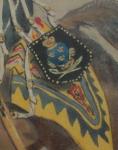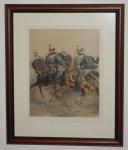-
Posts
429 -
Joined
-
Last visited
-
Days Won
1
Content Type
Profiles
Forums
Blogs
Gallery
Events
Store
Everything posted by GRA
-
Hello Christer! This trooper wears the uniform of the Life Regiment Hussars, which I can assure you are still alive and kicking to this day! The Västgöta Regiment however was disbanded in 1927 (a former cavalry regiment that lost its horses in, I believe, 1811, serving as infantry during the last century or so of its existence). If the photo dates from around WW1 or later, it'll probably be a conscript, as the professional troopers / NCO's would by then have worn the grey m/1910, the older m/1895's would have been worn by conscripts, sometimes mixed m/1895 top and m/1910 bottom (I've seen a photo from as late as 1934 showing this mix). /Jonas
-

RARE HISTORICAL MILITARIA PRINTS
GRA replied to Mervyn Mitton's topic in Great Britain: Research, Documentation & History
Here's some suggestions as to possible colonels, but does it have to be a colonel? Couldn't it be another at the time well-known regimental character? A medal is visible, which one? 1839.08.24 Gen. Sir William Keir Grant, KCB, GCH 1852.05.25 Lt-Gen. Archibald Money, CB 1858.08.26 Lt-Gen. Arthur Moyses William (Hill), 2nd Baron Sandys 1860.07.17 Lt-Gen. Sir Alexander Kennedy Clark-Kennedy, KCB, KH 1864.01.31 Gen. Sir John Bloomfield Gough, GCB 1891.09.23 Gen. George Calvert Clarke, CB /Jonas -

Moderators Choice Peninsular GSM?
GRA replied to Spasm's topic in Great Britain: Orders, Gallantry, Campaign Medals
One of these? http://www.dnw.co.uk/medals/resources/medalrolls/militarygeneralservice/ /Jonas -

Finland My Finnish Collection 1918-1945
GRA replied to christerd's topic in Northern European & Baltic States
That's the one I was thinking of! /Jonas -

Finland My Finnish Collection 1918-1945
GRA replied to christerd's topic in Northern European & Baltic States
Hello Christer! Nice ribbon bar, but do you really think it's an Order of the Sword??? It looks like green stripes instead of blue, could it be a unit commemorative medal/cross? /Jonas -

RARE HISTORICAL MILITARIA PRINTS
GRA replied to Mervyn Mitton's topic in Great Britain: Research, Documentation & History
Oops sorry, British thread, but at least I got the age reasonably right... Mervyn, please move my contribution if you want. /Jonas -

RARE HISTORICAL MILITARIA PRINTS
GRA replied to Mervyn Mitton's topic in Great Britain: Research, Documentation & History
-

RARE HISTORICAL MILITARIA PRINTS
GRA replied to Mervyn Mitton's topic in Great Britain: Research, Documentation & History
-

RARE HISTORICAL MILITARIA PRINTS
GRA replied to Mervyn Mitton's topic in Great Britain: Research, Documentation & History
Here's my humble contribution to the thread... A colour lithograph from Fritz von Dardel's "Svenska och Norska Arméerna samt flottorna i deras nuvarande uniformering" (The Contemporary Uniforms of the Swedish and Norwegian Armies and Navies), printed by Lemercier in Paris in the early 1860's. It's heading straight for the boy's room wall, whenever that room will be ready... /Jonas -
Just speculating now, but I'd say that the operators would be temporarily assigned from a specialist unit to the "unit in charge of the launch site". The launcher itself is, as you say, not exactly rocket science, but the message part of the operation would involve specialists. I'd be surprised if this was even a divisional asset (corps-level? army-level?), but there has to be someone on the forum who knows the organisation of the German army in WW2 being able to give a correct answer. /Jonas
-
Thank you Odulf, one learns something new every day! I agree with Simon and Brian, good work finding that website, very interesting. /Jonas
-
I agree with Simon, some sort of rocket firing device. I'm thinking the motor part of a mine-clearance "snake" - something pulling a hose of explosive out to full length before it is detonated clearing a path through AP (at least) and AT (probably) minefields and barbed wire. It is not high-precision work, and there are no aiming devices present on this device - just aim "in the general direction of". /Jonas PS. Simon, there's a breast eagle present, but it's not easy to catch. One of those woven ones?
-

Date of Cap?
GRA replied to Robin Lumsden's topic in Great Britain: Militaria: Badges, Uniforms & Equipment
Hello Toby! According to Brereton's "History of the 4th/7th Royal Dragoon Guards", it is the crest and motto of John Ligonier, who was the Colonel of 7th Dragoon Guards for 29 years. The Duke of Wellington's lion holds a banner as you say, and the motto is different too. /Jonas -

Date of Cap?
GRA replied to Robin Lumsden's topic in Great Britain: Militaria: Badges, Uniforms & Equipment
Hello Stuart! Wasn't it a Regular serving with the Yeomanry? If that was the case of that particular RSM, then the cap badge of the 7th Dragoon Guards is a good candidate too. /Jonas -

Sweden: General Carl C.son VAN HORN
GRA replied to Archer's topic in Northern European & Baltic States
William! On the Life photo there seems to be an officer to the left (British?, he's wearing the ribbon of the 1939-45 Star), whose last ribbon looks like the UNEF ribbon, von Horn returned to Palestine after his Congo mission, so he certainly met UNEF personnel on a regular basis even if he wasn't on the UNEF roll himself. No, I didn't know about the Finland thing. What I just found out though is that he had some problems as a young Second Lieutenant serving with Livgardet till häst (Horse Guards). His father and the GOC the Cavalry Inspection were brothers-in-law and they detested each other, predictably von Horn was caught in between a rock and a hard place when his regiment was up for review! He did however seem to have performed less than average on field exercises, which may have been a legit reason for the general to be less than satisfied with him. /Jonas -

Sweden: General Carl C.son VAN HORN
GRA replied to Archer's topic in Northern European & Baltic States
-

Sweden: General Carl C.son VAN HORN
GRA replied to Archer's topic in Northern European & Baltic States
William, I don't know about UNEF, according to Swedish Wikipedia, it seems like UNTSO, ONUC and UNYOM were the only UN missions he served in (but then again, it's Wikipedia...). He also served as a military attaché in Norway and Denmark, so he might have got something from that service too (ribbon #10 of 15, Norwegian?). Does he wear a couple of UN ribbons as #2 and #3? It looks like the early ONUC version and UNTSO. /Jonas -

Sweden: General Carl C.son VAN HORN
GRA replied to Archer's topic in Northern European & Baltic States
Hello William! A/ Here's a link to a photo: Carl von Horn B/ He died in 1989 As to his ribbons, at a quick glance I saw the Order of the Sword, some WW2 Finnish medals as well as some Volunteer Associations medals, nothing unusual for an officer of his rank at that time. I'll see if there's a colour photo lurking somewhere. /Jonas -
Hello Mervyn! This m/1896 bayonet could well have been used by the Swedish Navy - provided of course they were issued with it (it's beyond my knowledge) - but the marking is that of the Eskilstuna Jernmanufaktur, thus a maker's mark. I don't know if Swedish bayonets could be traced to certain units, there would be thousands issued, but sabres issued to the mounted units were marked down to squadron/battery. If the blurry stamp is what I think it is, then it could be the individual stamp within a certain unit (company/regiment). /Jonas
-
Hello Timo! That looks like you've got a Cheshire Regiment blazer badge there, I don't know about the value, but a quick Google session turned up prices ~£10 (but yours seems to be bullion, so maybe a little more?). Why not use it in a display of medals to the Cheshires instead of selling it? (Then again, my opinion might be biased, I'm a man of the cloth myself!) /Jonas
-

The Peaked or Visor Cap
GRA replied to Stuart Bates's topic in Great Britain: Militaria: Badges, Uniforms & Equipment
Thank you Stuart! It seems like in the British Army, regimental traditions and whims (and, dare I say, in a few cases also pigheadedness) by far outweighs Dress Regulations if need be, however that's how lasting traditions are made! Perhaps, as you imply, the Yeomanry (as all equivalent units) ought to have been kept out, as a combination of eccentric COs and "second rank position" in the Army could complicate the equation as to introduction / phasing out of certain parts of uniforms. A very interesting thread. /Jonas -

The Peaked or Visor Cap
GRA replied to Stuart Bates's topic in Great Britain: Militaria: Badges, Uniforms & Equipment
Hello Stuart! In the book you refer to (The Kent Yeomanry, by Boris Mollo, right?), on the page opposite the ORs of 1905, there's the following caption to a 1913 photo: "The pillbox forage cap has finally been replaced by a dark blue peaked cap with the regimental badge." Doesn't that imply that the pillbox cap could have been replaced even later than 1907? And forgive a novice (and do please educate me!), but on page 48 a group of ORs in 1913, also of the West Kent Yeomanry, wears torrin caps. Another cap replacing the pillbox cap and in its turn being replaced by the peaked cap? /Jonas -
Yes, I guess we could come up with a dozen plausible translations to that particular word between the two of us, and to top it off, we face a motto from a century ago, with another linguistic take on things. Good points, Peter! /Jonas
-
Hello Jeff! 3rd place in association championships (probably, "Korps" indicates an older, more military-oriented name for "förening", Korps M - föreningsmästerskap - association championships), whether the championships were open or members only I wouldn't know. "For home and hearth", and old-style motto indicating patriotic origin, these shooting associations were, as I mentioned before, connected with the defence of the country. The members were certainly skilled riflemen, but soldiers they were not (the occasional ex-soldier could probably be found among the members, but this was above all a civilian, patriotic and democratic organisation). In the early 20th Century, just before The Great War, the military skills entered the Volunteer movement agenda too, but that is another story and to a part performed by different organisations... Shooting association/club /Jonas
-
Hello Jeff! I haven't seen this particular medal before, but it is a medal from a shooting association, and the likes of it aren't uncommon. A lot of these associations were founded in the late 19th Century and early 20th Century, and I think they were supported one way or the other by the Swedish Army (weapons, instructors, ammunition etc), in any case they were a significant part of the Volunteer movement in Sweden. Striberg is a (former) mining town in Sweden, and you can see the iron symbol on the medal. I don't know whether the medal was awarded for shooting excellence / shooting competition victory / "association work" (being an association board member) or long-lasting membership, but most probably one of the first options. Is there any engraving on the reverse? Is there a maker's mark (Sporrong, perhaps)? /Jonas







